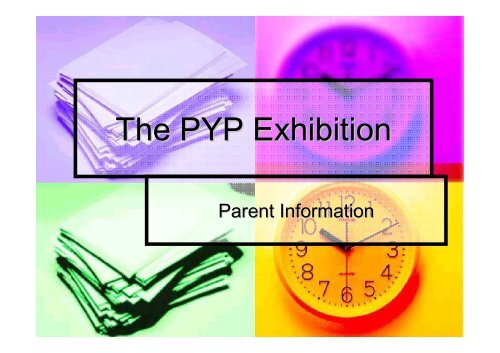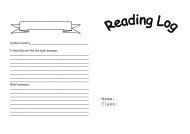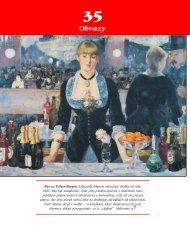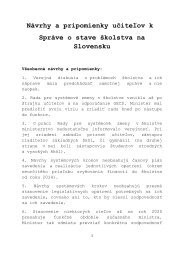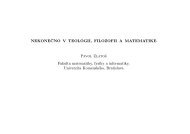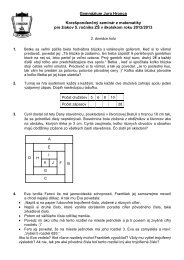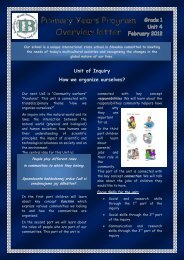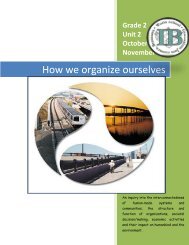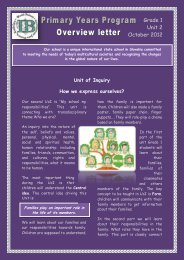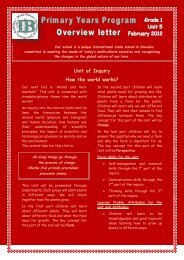The PYP Exhibition
The PYP Exhibition
The PYP Exhibition
You also want an ePaper? Increase the reach of your titles
YUMPU automatically turns print PDFs into web optimized ePapers that Google loves.
<strong>The</strong> <strong>PYP</strong> <strong>Exhibition</strong>Parent Information
What is the purpose of the<strong>Exhibition</strong>?• to engage in an in-depth, collaborative inquiry• to demonstrate independence and responsibility for their ownlearning• to provide opportunities to explore multiple perspectives• to synthesize and apply their learning• to reflect upon their journey through the <strong>PYP</strong>• to provide an authentic process for assessing student understanding• to demonstrate how students can take action as a result of theirlearning• to unite the students, teachers, parents and other members of theschool community in a collaborative experience that incorporatesthe essential elements of the <strong>PYP</strong>• to celebrate the transition of learners from primary tomiddle/secondary education.
<strong>The</strong> role of the student• Understand the purpose and requirements of the exhibition• participate in selecting real-life issues for the exhibition• develop and carry out the open-ended inquiry collaborative• plan learning and assessment experiences; these should involveindependent and collaborative work and students should beinvolved in all stages of the planning and staging of the exhibition• demonstrate an understanding of the components of the <strong>PYP</strong>, inparticular the IB learner profile• demonstrate an understanding of the five essential elements—knowledge, concepts, skills, attitudes and action• communicate effectively with teachers, peers and parents• carry out self-assessment and peer assessment
<strong>The</strong> role of the student (continued)• select and utilize a variety of strategies and resources to meet theoutcomes of the inquiry; wherever possible, students should use avariety of source materials, such as first-hand experiences,interviews, surveys, field visits, artifacts, science investigations,working models, not just book and/or Internet research• be academically honest when referring to their sources ofinformation• reflect on the components of and processes involved in theexhibition; they should keep a journal or portfolio of their planning,draft pieces of work, sketches and photographs of work in progressas well as the final product• celebrate their learning by presenting the exhibition to the schoolcommunity.
<strong>The</strong> role of parents• have an understanding of the purpose and requirements of theexhibition• be informed by reading newsletters, attending meetings, checkingwebsites, talking with students• help students to access resources—people, places, media andinformation• provide expert subject knowledge where applicable• act as mentors as required or appropriate• encourage independent inquiry and respect student ownership ofthe process• have an opportunity to reflect on and give feedback on theexhibition• celebrate with the students by attending the staging of theexhibition
Essentials for assessment• Exhibit the attributes of the IB Learner Profile and display attitudesthat relate to people, the environment and their learning throughoutthe process• Incorporate all 8 key concepts• Synthesize aspects of all transdisciplinary themes• Apply skills from all five sets of transdisciplinary skills• Explore knowledge that is significant and relevant• Demonstrate engagement in action• Collaborate in a student-led, in-depth inquiry• Keep records of the process of planning, engagement, reflectionand action• Include ongoing, rigorous assessment of the process of eachindividual’s contribution to and understanding of the exhibition and asummative assessment and reflection on the event itself


